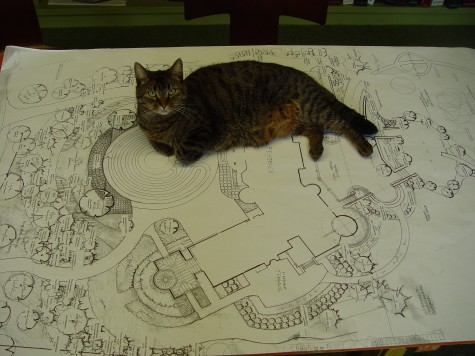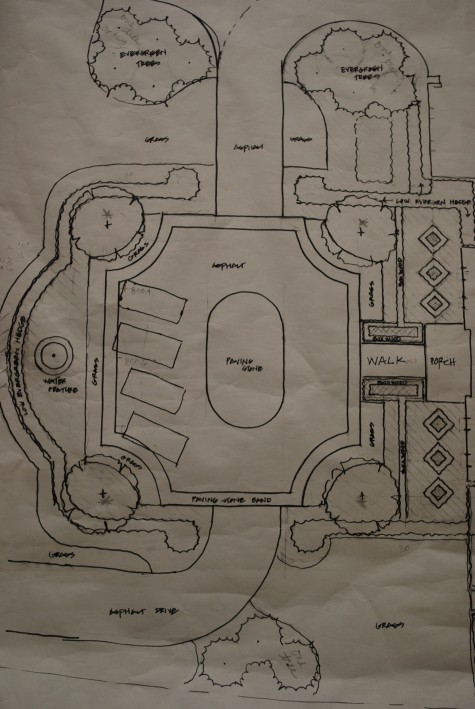 I have been consulting with a client who has an existing landscape. They know it is unfinished, and unresolved. They gave me their drawing in tandem with a request. We cannot really explain what is not working here, but can you help us get a little room for something colorful and lively? I plan to help them. So what do I not like about this drawing? The drawing is not color coded. I can read lines, but I do this for a living. A group of lines-not friendly to a client. Would it not be good to differentiate the like trees from the grass from the like and the different shrubs? A landscape drawing may make me think about the artful signature that is a line-but a landscape schematic needs to explain clearly its idea to its intended. Where is the house? What part is the driveway, and what part is the living landscape? Where will the tulips go? Four rectangles at an angle strongly suggest the parking scheme-at least to me. But where is the living and breathing part? Where in this drawing is what will make architecture and nature intersect, beautifully? Everyone wants to come home, and be glad for where they live-a good landscape plan fosters this. A clearly drawn plan will show if this is working, or not.
I have been consulting with a client who has an existing landscape. They know it is unfinished, and unresolved. They gave me their drawing in tandem with a request. We cannot really explain what is not working here, but can you help us get a little room for something colorful and lively? I plan to help them. So what do I not like about this drawing? The drawing is not color coded. I can read lines, but I do this for a living. A group of lines-not friendly to a client. Would it not be good to differentiate the like trees from the grass from the like and the different shrubs? A landscape drawing may make me think about the artful signature that is a line-but a landscape schematic needs to explain clearly its idea to its intended. Where is the house? What part is the driveway, and what part is the living landscape? Where will the tulips go? Four rectangles at an angle strongly suggest the parking scheme-at least to me. But where is the living and breathing part? Where in this drawing is what will make architecture and nature intersect, beautifully? Everyone wants to come home, and be glad for where they live-a good landscape plan fosters this. A clearly drawn plan will show if this is working, or not.
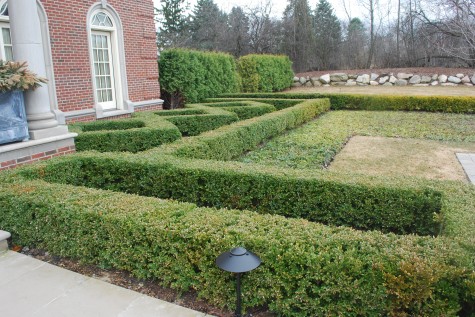 My client has no end of boxwood-strikingly well grown, and maintained. Miles and miles of it. Well grown plants do not necessarily make a coherent and beautiful landscape-I tell them. I have plenty of personal experience. My perfectly grown clematis, the hybrid known as Sho-Un, was planted in a spot the most rank amateur gardener would avoid-what was my problem? Five years later, I had to move it-and in moving it, I killed it. I understood my clients concern about changing up many miles of beautifully grown plants., but in this case, I think it is worth the trouble.
My client has no end of boxwood-strikingly well grown, and maintained. Miles and miles of it. Well grown plants do not necessarily make a coherent and beautiful landscape-I tell them. I have plenty of personal experience. My perfectly grown clematis, the hybrid known as Sho-Un, was planted in a spot the most rank amateur gardener would avoid-what was my problem? Five years later, I had to move it-and in moving it, I killed it. I understood my clients concern about changing up many miles of beautifully grown plants., but in this case, I think it is worth the trouble.
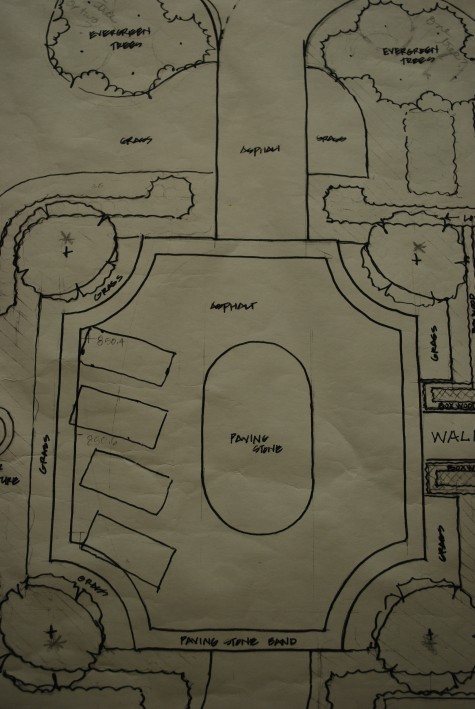 The dominant feature of this entry landscape drawing is a drivecourt of monumental proportions. I could stage a rock concert here, or a reception for four hundred people, and have room to spare. As much as I admire its bold scale, it seems natural to key the landscape elements in recognition and reinforcement of the shape it describes. There will be no ignoring it. It is large enough that a landscape feature could exist in that oval of paving stone, and not obstruct traffic in the least.
The dominant feature of this entry landscape drawing is a drivecourt of monumental proportions. I could stage a rock concert here, or a reception for four hundred people, and have room to spare. As much as I admire its bold scale, it seems natural to key the landscape elements in recognition and reinforcement of the shape it describes. There will be no ignoring it. It is large enough that a landscape feature could exist in that oval of paving stone, and not obstruct traffic in the least.
 This photograph may give you a better idea of the drivecourt square footage in question. The center oval detailed in a different material from the rest of the asphalt drive was a good move. Nonetheless, we are looking at a giant space here. A sweeping move of this scale needs friendly and solid company. The existing landscape pays no mind, does not follow up a gesture of this scale. The drivecourt as it stands-lonely. The boxwood look very small, and not as visually important as they should. Some larger growing plant element backing up that boxwood will add weight and visual heft.
This photograph may give you a better idea of the drivecourt square footage in question. The center oval detailed in a different material from the rest of the asphalt drive was a good move. Nonetheless, we are looking at a giant space here. A sweeping move of this scale needs friendly and solid company. The existing landscape pays no mind, does not follow up a gesture of this scale. The drivecourt as it stands-lonely. The boxwood look very small, and not as visually important as they should. Some larger growing plant element backing up that boxwood will add weight and visual heft.
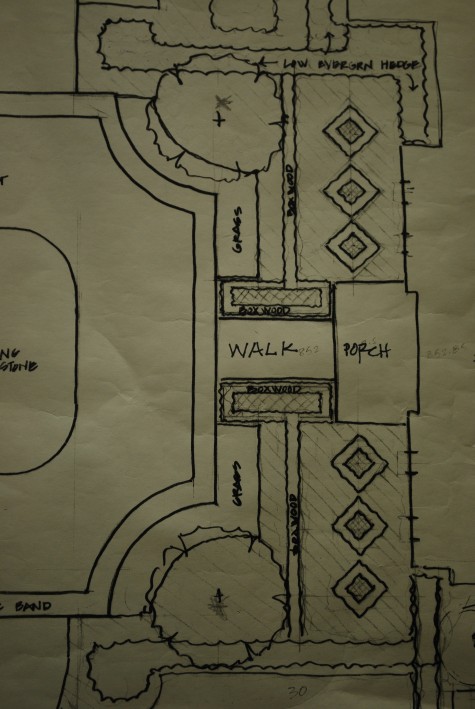 The walk to the front door needs to set a mood. Hello, and welcome to my home-this idea does fine, for starters. Beyond the welcome, that walk should represent a distinctive and strong hello. A house is a very large object; the landscape should help sit that structure down onto the land.
The walk to the front door needs to set a mood. Hello, and welcome to my home-this idea does fine, for starters. Beyond the welcome, that walk should represent a distinctive and strong hello. A house is a very large object; the landscape should help sit that structure down onto the land.
 These gorgeously grown diamonds of boxwood are just that-gorgeously grown diamonds. This shape and configuration is outside the language established by the architecture of the house, and its attendant drivecourt. The drivecourt, in my mind, is all about beautiful curves, and not much about diamonds. What will I do with these boxwood diamonds?
These gorgeously grown diamonds of boxwood are just that-gorgeously grown diamonds. This shape and configuration is outside the language established by the architecture of the house, and its attendant drivecourt. The drivecourt, in my mind, is all about beautiful curves, and not much about diamonds. What will I do with these boxwood diamonds?
 The original drawing is focused on the drivecourt, with no indication of how that landscape would sit on the property as a whole. My perspective? Every landscape composition needs to be detailed with all the edges in evidence. The foreground space implies a midground space-and a far view. I orient my drawings to the primary view-from the front door out. I redrew their landcape plan in an effort to make the house, drivecourt and landscape more harmonic, and less fussy. What would you want to see every day? My idea-emphasize what is already there in such a way that the big picture is clearly stated.
The original drawing is focused on the drivecourt, with no indication of how that landscape would sit on the property as a whole. My perspective? Every landscape composition needs to be detailed with all the edges in evidence. The foreground space implies a midground space-and a far view. I orient my drawings to the primary view-from the front door out. I redrew their landcape plan in an effort to make the house, drivecourt and landscape more harmonic, and less fussy. What would you want to see every day? My idea-emphasize what is already there in such a way that the big picture is clearly stated.
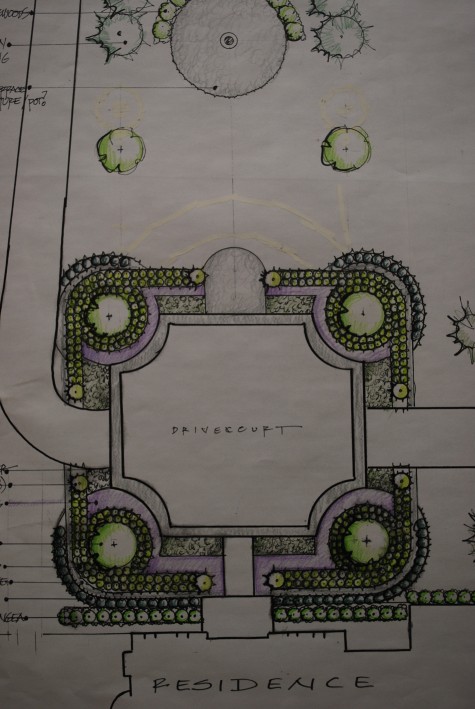 This drivecourt-of massive proportion and clear design-I have a mind to go along amicably, and reinforce its big statement. The big statement in any landscape-I would advise you to figure out what that statement is, and go for broke-in support. I come in contact with plenty of statements not of my choosing or design-this does not bother me in the least. Any existing big statement implies consent. I have no need to go back to the beginning. I like to put my weight to any idea a client felt comfortable consenting to. If you have inherited a landscape, what are the strong elements well worth keeping?
This drivecourt-of massive proportion and clear design-I have a mind to go along amicably, and reinforce its big statement. The big statement in any landscape-I would advise you to figure out what that statement is, and go for broke-in support. I come in contact with plenty of statements not of my choosing or design-this does not bother me in the least. Any existing big statement implies consent. I have no need to go back to the beginning. I like to put my weight to any idea a client felt comfortable consenting to. If you have inherited a landscape, what are the strong elements well worth keeping?
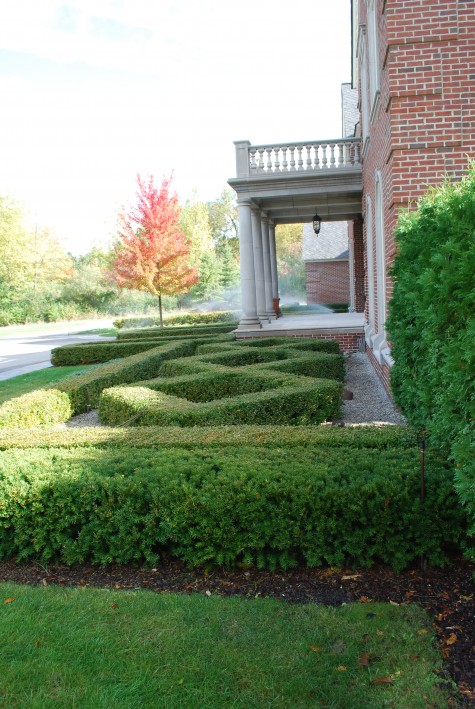 The both of them understood the difference between beautifully grown plants, and a beautiful landscape. We spent the better part of two hours going over their issues. Hopefully moving some plants, and adding a little of this and that will better serve them-and showcase all those beautiful plants.
The both of them understood the difference between beautifully grown plants, and a beautiful landscape. We spent the better part of two hours going over their issues. Hopefully moving some plants, and adding a little of this and that will better serve them-and showcase all those beautiful plants.
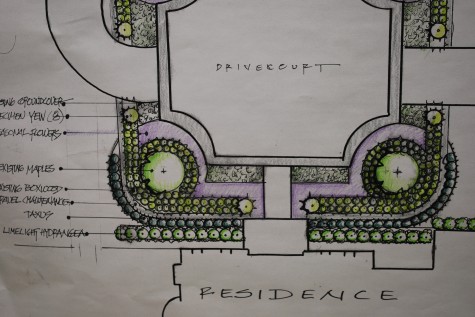
What they see, near and far, should provide visual exploration of the big picture.
 A good bit of my working life revolves around prints. A print is any mark made on or impressed into a surface-like these footprints imprinted in the snow. My boots aside, I draw prints. I explain them-I work off them. The drawing/print of the landscape is a two dimensional means by which I am able to explain my ideas about a sculpture with a client. Installations are done from prints that are drawn to scale. A print which is drawn exactly the same size as a property would need a piece of paper as big as that property; I doubt I need to detail the problems that would arise with this. So one foot of length on your property would be represented by 1/10th of an inch on my print. A properly scaled, flat, and miniature version of my idea is what you would get from me.
A good bit of my working life revolves around prints. A print is any mark made on or impressed into a surface-like these footprints imprinted in the snow. My boots aside, I draw prints. I explain them-I work off them. The drawing/print of the landscape is a two dimensional means by which I am able to explain my ideas about a sculpture with a client. Installations are done from prints that are drawn to scale. A print which is drawn exactly the same size as a property would need a piece of paper as big as that property; I doubt I need to detail the problems that would arise with this. So one foot of length on your property would be represented by 1/10th of an inch on my print. A properly scaled, flat, and miniature version of my idea is what you would get from me. 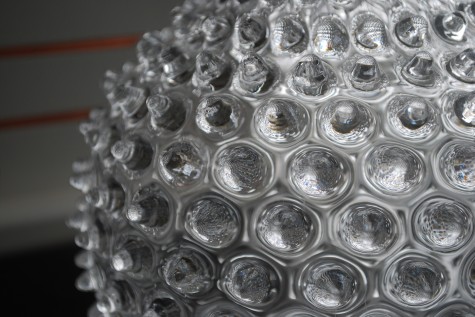 Prints are not easy to read, if you have not had practice. Prints are lines and shapes that make patterns. A pattern you might see if you were flying over your property. Who does that? Google Earth can provide you with a print that has recorded the patterns evident on your property. Look up your property-there may be something there that inspires you. The hobnail glass pictured above has a distinctive pattern, but also a volume, a sculptural shape. Each circle is in fact a tuft of glass; the location of each tuft in turn describes the curve of this pitcher. A print of the pattern of this glass would give you the plan view-the view from a bird flying over. Flat and circular, the pitcher shape in outline. The sculpture which is this pitcher is another story- entirely.
Prints are not easy to read, if you have not had practice. Prints are lines and shapes that make patterns. A pattern you might see if you were flying over your property. Who does that? Google Earth can provide you with a print that has recorded the patterns evident on your property. Look up your property-there may be something there that inspires you. The hobnail glass pictured above has a distinctive pattern, but also a volume, a sculptural shape. Each circle is in fact a tuft of glass; the location of each tuft in turn describes the curve of this pitcher. A print of the pattern of this glass would give you the plan view-the view from a bird flying over. Flat and circular, the pitcher shape in outline. The sculpture which is this pitcher is another story- entirely.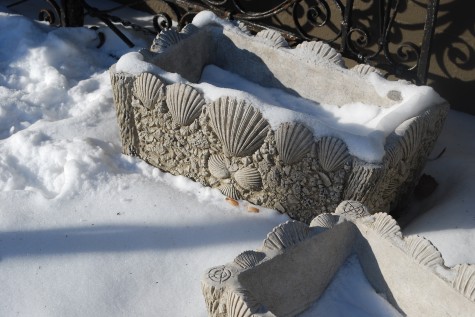 This concrete pot is made from a mold. The mold material records a three dimensional surface in every detail. I have seen the production print for this pot; I could barely follow it. It was very much like trying to read words from a language not my own. Where am I going with this? What a first rate landscape designer has to offer may be more than worth your while-or not. But for sure, you need to read their print. But that big fluid and certainly sculptural situation which is your property-no print truly describes that. Get involved with your designer. Speak your peace, and then some.
This concrete pot is made from a mold. The mold material records a three dimensional surface in every detail. I have seen the production print for this pot; I could barely follow it. It was very much like trying to read words from a language not my own. Where am I going with this? What a first rate landscape designer has to offer may be more than worth your while-or not. But for sure, you need to read their print. But that big fluid and certainly sculptural situation which is your property-no print truly describes that. Get involved with your designer. Speak your peace, and then some. 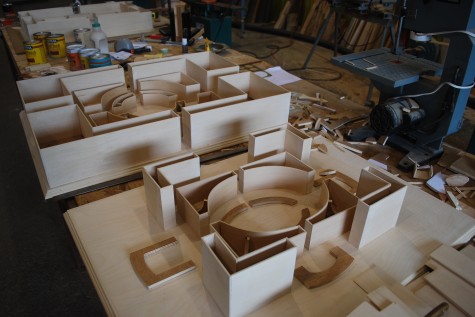
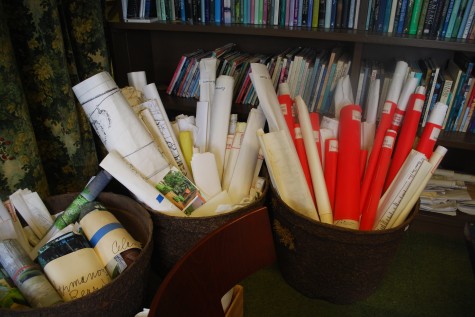 Steve tore apart my entire office, to clean and paint. Over the course of 25 years, I have amassed a goodly number of prints. He stuffed them into a number of fiber pots. Good, bad, or indifferent, there are lots of them. He wants me to go through them, and decide which old prints I want to keep. I have not told him yet, but I want to keep all of them. These marks on a lot of pages add up to a life. Many times I stuff mud stained prints into my back pocket, and work with what is in front of me. But those original prints-I save them. The print is but a mark recording intent-nothing more. Intent-this counts for a lot, from my side of the aisle. The skill of the drawing-don’t be fooled. Beautiful landscapes are about a lot of things-but gorgeous drawings of poor designs most certainly exist. My drawings are simple-but they involve some doing that might require years.
Steve tore apart my entire office, to clean and paint. Over the course of 25 years, I have amassed a goodly number of prints. He stuffed them into a number of fiber pots. Good, bad, or indifferent, there are lots of them. He wants me to go through them, and decide which old prints I want to keep. I have not told him yet, but I want to keep all of them. These marks on a lot of pages add up to a life. Many times I stuff mud stained prints into my back pocket, and work with what is in front of me. But those original prints-I save them. The print is but a mark recording intent-nothing more. Intent-this counts for a lot, from my side of the aisle. The skill of the drawing-don’t be fooled. Beautiful landscapes are about a lot of things-but gorgeous drawings of poor designs most certainly exist. My drawings are simple-but they involve some doing that might require years. 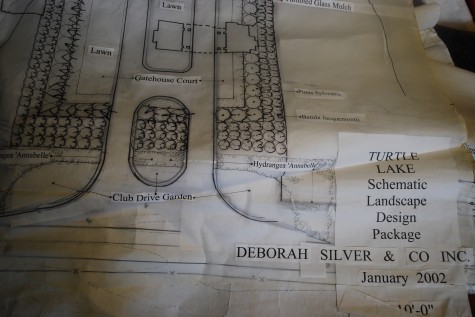 I think, design, and draw for a living. This is how I buy groceries, and pay my mortgage-but enough about me. Should you be designing gardens for yourself, I would encourage you to put a pencil to a page. What is in your heart-draw this. Take your mortgage survey and blow it up. Look at your spaces, your edges, how your house sits on your property. Loosen up. Make marks on the page. A print is a drawing-not a committment to build. Make lots of drawings. Sleep on everything you draw. Erase, and start over. Don’t bother to diss your drawing skills. No beautiful garden was ever about skilled drawing.
I think, design, and draw for a living. This is how I buy groceries, and pay my mortgage-but enough about me. Should you be designing gardens for yourself, I would encourage you to put a pencil to a page. What is in your heart-draw this. Take your mortgage survey and blow it up. Look at your spaces, your edges, how your house sits on your property. Loosen up. Make marks on the page. A print is a drawing-not a committment to build. Make lots of drawings. Sleep on everything you draw. Erase, and start over. Don’t bother to diss your drawing skills. No beautiful garden was ever about skilled drawing. 